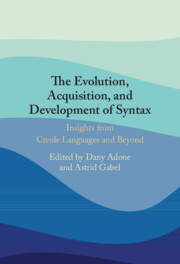Book contents
- The Evolution, Acquisition, and Development of Syntax
- The Evolution, Acquisition, and Development of Syntax
- Copyright page
- Contents
- Figures
- Tables
- Contributors
- Acknowledgments
- Abbreviations
- 1 Introduction
- Part I The Evolution of Syntax
- Part II The Acquisition of Syntax
- 7 Acquisition of Negation in Jamaican
- 8 Missing Subjects in Creole Acquisition: Insights from Jamaican and Morisyen
- 9 Home Signs as a Window on Language Creation
- 10 Young Children Creating Grammars: Are Twins’ Languages Like Pidgins or Creoles?
- Part III The Development of Syntax
- Index
- References
9 - Home Signs as a Window on Language Creation
from Part II - The Acquisition of Syntax
Published online by Cambridge University Press: 19 February 2025
- The Evolution, Acquisition, and Development of Syntax
- The Evolution, Acquisition, and Development of Syntax
- Copyright page
- Contents
- Figures
- Tables
- Contributors
- Acknowledgments
- Abbreviations
- 1 Introduction
- Part I The Evolution of Syntax
- Part II The Acquisition of Syntax
- 7 Acquisition of Negation in Jamaican
- 8 Missing Subjects in Creole Acquisition: Insights from Jamaican and Morisyen
- 9 Home Signs as a Window on Language Creation
- 10 Young Children Creating Grammars: Are Twins’ Languages Like Pidgins or Creoles?
- Part III The Development of Syntax
- Index
- References
Summary
Adone’s chapter focuses on home signs, bringing to light the acquisition process against a background of ‘normless’ language environment (Bakker, this volume) and in the absence of exposure to a ‘conventional language model’ (Adone 2005). She thus discusses what absence of exposure means when looking at children home signers. In comparison to previous work, Adone shows that the absence of a conventional language model does not mean complete absence of input. She argues that children ‘scan’ their environment for input and use every bit of language-related information as input. Adone further argues that the verb chains in child home signers’ initial grammars develop into adult-like serial verb constructions. This development can be interpreted as evidence for the view that children exploit input to the best of their ability to ‘create language’.
Keywords
Information
- Type
- Chapter
- Information
- The Evolution, Acquisition and Development of SyntaxInsights from Creole Languages and Beyond, pp. 154 - 169Publisher: Cambridge University PressPrint publication year: 2025
